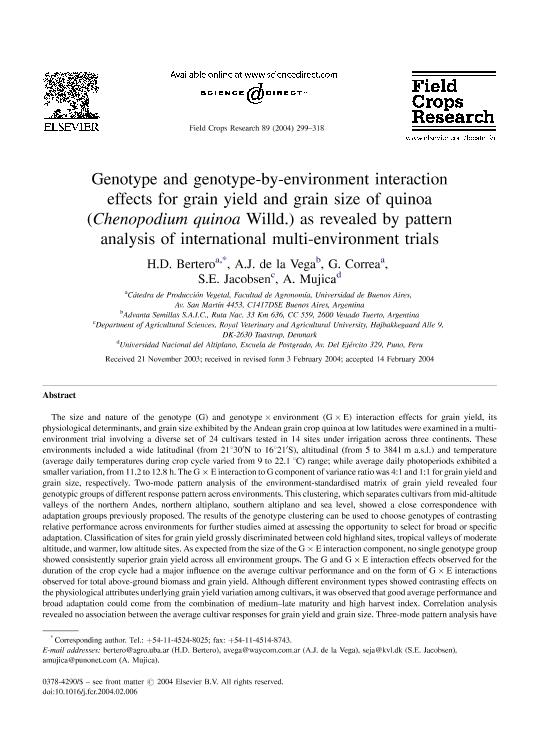Mostrar el registro sencillo del ítem
dc.contributor.author
Bertero, Hector Daniel

dc.contributor.author
De La Vega, A. J.
dc.contributor.author
Correa Tedesco, Guillermo Oscar

dc.contributor.author
Jacobsen, S. E.
dc.contributor.author
Mujica, A.
dc.date.available
2022-01-26T16:51:24Z
dc.date.issued
2004-10
dc.identifier.citation
Bertero, Hector Daniel; De La Vega, A. J.; Correa Tedesco, Guillermo Oscar; Jacobsen, S. E.; Mujica, A.; Genotype and genotype-by-environment interaction effects for grain yield and grain size of quinoa (Chenopodium quinoa Willd.) as revealed by pattern analysis of international multi-environment trials; Elsevier Science; Field Crops Research; 89; 2-3; 10-2004; 299-318
dc.identifier.issn
0378-4290
dc.identifier.uri
http://hdl.handle.net/11336/150694
dc.description.abstract
The size and nature of the genotype (G) and genotype×environment (G×E) interaction effects for grain yield, its physiological determinants, and grain size exhibited by the Andean grain crop quinoa at low latitudes were examined in a multi-environment trial involving a diverse set of 24 cultivars tested in 14 sites under irrigation across three continents. These environments included a wide latitudinal (from 21°30′N to 16°21′S), altitudinal (from 5 to 3841 m a.s.l.) and temperature (average daily temperatures during crop cycle varied from 9 to 22.1°C) range; while average daily photoperiods exhibited a smaller variation, from 11.2 to 12.8 h. The G×E interaction to G component of variance ratio was 4:1 and 1:1 for grain yield and grain size, respectively. Two-mode pattern analysis of the environment-standardised matrix of grain yield revealed four genotypic groups of different response pattern across environments. This clustering, which separates cultivars from mid-altitude valleys of the northern Andes, northern altiplano, southern altiplano and sea level, showed a close correspondence with adaptation groups previously proposed. The results of the genotype clustering can be used to choose genotypes of contrasting relative performance across environments for further studies aimed at assessing the opportunity to select for broad or specific adaptation. Classification of sites for grain yield grossly discriminated between cold highland sites, tropical valleys of moderate altitude, and warmer, low altitude sites. As expected from the size of the G×E interaction component, no single genotype group showed consistently superior grain yield across all environment groups. The G and G×E interaction effects observed for the duration of the crop cycle had a major influence on the average cultivar performance and on the form of G×E interactions observed for total above-ground biomass and grain yield. Although different environment types showed contrasting effects on the physiological attributes underlying grain yield variation among cultivars, it was observed that good average performance and broad adaptation could come from the combination of medium-late maturity and high harvest index. Correlation analysis revealed no association between the average cultivar responses for grain yield and grain size. Three-mode pattern analysis have also shown no association between the G×E interaction effects for both traits. Both observations indicate that simultaneous progress for grain yield and grain size can be expected from selection.
dc.format
application/pdf
dc.language.iso
eng
dc.publisher
Elsevier Science

dc.rights
info:eu-repo/semantics/openAccess
dc.rights.uri
https://creativecommons.org/licenses/by-nc-sa/2.5/ar/
dc.subject
CHENOPODIUM QUINOA
dc.subject
GENOTYPE×ENVIRONMENT INTERACTION
dc.subject
GRAIN SIZE
dc.subject
GRAIN YIELD DETERMINANTS
dc.subject
PATTERN ANALYSIS
dc.subject
QUINOA
dc.subject
THREE-MODE PRINCIPAL COMPONENT ANALYSIS
dc.subject.classification
Silvicultura

dc.subject.classification
Agricultura, Silvicultura y Pesca

dc.subject.classification
CIENCIAS AGRÍCOLAS

dc.title
Genotype and genotype-by-environment interaction effects for grain yield and grain size of quinoa (Chenopodium quinoa Willd.) as revealed by pattern analysis of international multi-environment trials
dc.type
info:eu-repo/semantics/article
dc.type
info:ar-repo/semantics/artículo
dc.type
info:eu-repo/semantics/publishedVersion
dc.date.updated
2022-01-06T15:03:36Z
dc.identifier.eissn
1872-6852
dc.journal.volume
89
dc.journal.number
2-3
dc.journal.pagination
299-318
dc.journal.pais
Países Bajos

dc.journal.ciudad
Amsterdam
dc.description.fil
Fil: Bertero, Hector Daniel. Consejo Nacional de Investigaciones Científicas y Técnicas. Oficina de Coordinación Administrativa Parque Centenario; Argentina. Universidad de Buenos Aires. Facultad de Agronomía. Departamento de Producción Vegetal; Argentina
dc.description.fil
Fil: De La Vega, A. J.. Advanta Semillas S.A.I.C.; Argentina
dc.description.fil
Fil: Correa Tedesco, Guillermo Oscar. Consejo Nacional de Investigaciones Científicas y Técnicas. Oficina de Coordinación Administrativa Parque Centenario; Argentina. Universidad de Buenos Aires. Facultad de Agronomía. Departamento de Producción Vegetal; Argentina
dc.description.fil
Fil: Jacobsen, S. E.. Royal Veterinary and Agricultural University; Dinamarca
dc.description.fil
Fil: Mujica, A.. Universidad Nacional del Altiplano; Perú
dc.journal.title
Field Crops Research

dc.relation.alternativeid
info:eu-repo/semantics/altIdentifier/url/https://www.sciencedirect.com/science/article/pii/S0378429004000619
dc.relation.alternativeid
info:eu-repo/semantics/altIdentifier/doi/http://dx.doi.org/10.1016/j.fcr.2004.02.006
Archivos asociados
